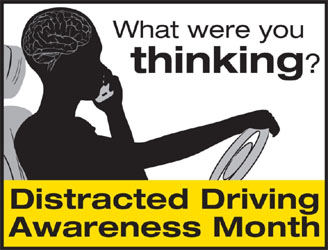Girls More Inclined to Use e-Devices while Driving
Teen girls are twice as likely as teen boys to use cell phones and other electronic devices while driving, according to a new in-car video study released today, March 26, by the AAA Foundation for Traffic Safety.
Electronic devices were the most commonly observed distracted driving activity for new teen drivers of both genders, although video captured many other serious distractions as well.
Meanwhile, the National Highway Traffic Safety Administration (NHTSA) reports that distracted driving is the number one killer of American teens. Nearly 500,000 young adults each year are injured due to various forms of distracted driving, including texting while driving. (Read: Watch Out, It May be Your Last Text from Your Car)
“Cell phones, texting, personal grooming, and reaching for things in the car were among the most common distracting activities found when cameras were put in new teen drivers’ cars,” said AAA Foundation president and CEO Peter Kissinger.
“This new study provides the best view we’ve had about how and when teens engage in distracted driving behaviors believed to contribute to making car crashes the leading cause of death for teenagers.”
Distracted Driving Among Newly Licensed Teen Drivers is stated to be the first study using in-car video footage to specifically focus on teen distracted driving. Researchers at the UNC Highway Safety Research Center identified the prevalence and consequences of various distracted driver behaviors and distracting conditions among teens during high g-force maneuvers such as swerving, hard braking, or rapid acceleration.
Among the findings: the leading cause of distraction for all teens was the use of electronic devices, which was seen in seven percent of the video clips analyzed. Other than electronic device usage, teens engaged in some form of potentially distracted behavior in 15 percent of clips, of which adjusting controls, personal grooming, and eating or drinking were the most common.
Many of the distracting behaviors – including use of electronic devices – were more prevalent among the older teens in the study group, suggesting rapid changes in these behaviors as teens get more comfortable behind the wheel.
Gender played a role in some of the distractions observed. Females were nearly twice as likely as males to use an electronic device while driving, and overall were nearly 10 percent more likely to be observed engaging in other distracted behaviors, such as reaching for an object in the vehicle (nearly 50 percent more likely than males) and eating or drinking (nearly 25 percent more likely).
Males, on the other hand, were roughly twice as likely to turn around in their seats while driving, and were also more likely to communicate with people outside of the vehicle.
“The gender differences with regard to distraction observed in this study raise some points that we’ll want to investigate in future projects,” Kissinger said. “Every insight we gain into driver behavior has the potential to lead us to new risk management strategies.”
The data for this report came from an analysis of video clips collected as part of a three-phase naturalistic study of 50 North Carolina families with novice teen drivers. The first study looked at how parents supervise their teens during the learner’s stage of GDL, and the second examined how teen behaviors and driving conditions shift during the transition to unsupervised driving.
For the current study, 7,858 clips from the first six months of unsupervised driving were re-analyzed to investigate distraction specifically.
With traffic crashes remaining the leading cause of death for young Americans, the AAA Foundation has an established focus area on teen driver safety.
Established in 1947, the AAA Foundation for Traffic Safety is a not-for-profit, publicly supported charitable educational and research organization.
Photo courtesy: AAA Foundation
💛 Support Independent Journalism
If you find RMN News useful, please consider supporting us.




